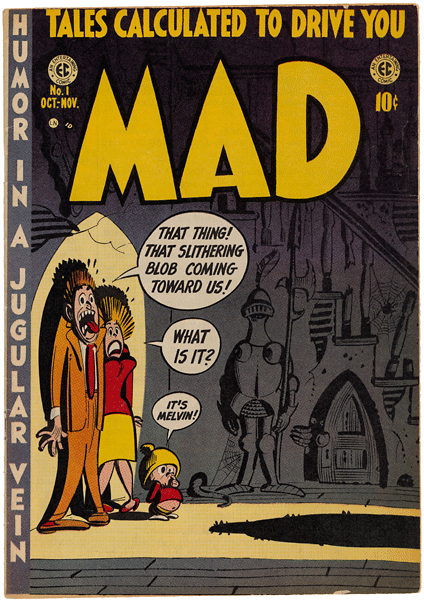Mad Magazine
Listen to the Recess! Clip
| Author | John Cech |
| Air Date | 3/21/2005 |

Mad Magazine Transcript
It’s the birthday this month of Bill Gaines, the publisher of one of the edgiest institutions in American childhood, Mad Magazine. Since its first appearance in comic book form in the fall of 1952, Mad’s brand of outlandish, satiric humor was one of the most delightfully, almost taboo things to come along for kids in a long, long time. Parents were a bit doubtful of all the fun-poking lunacy (as parents usually are), but at least the comic book wasn’t pedaling real gore and mayhem, as many comic books were at the time. In fact, comic books were under attack in the press and in the halls of congress in the early 1950s because of the appearance of some of the earliest sociological studies that examined the connections between violent entertainment and violent behavior in young people. Comic books contributed, in the famous phrase of one researcher, to a “Seduction of the Innocent,” and this argument lead to the Comics Code.
Mad, however, could fly under this sanitizing radar, because it could always claim that it was a vehicle for humor, albeit “humor in a jugular vein,” as its motto explained. In its earliest issues, Mad used horror, the macabre, and the tropes of the crime comic book to mock these and many other popular genres. It satirized other magazines, the advertising world, and (frequently) modern art, and it explained the Mona Lisa’s smile (she’s holding a copy of Mad in a famous cover from 1954). But after several years of providing the public with this immediately and highly successful comic book, Harvey Kurtzman, the guiding imagination behind Mad, was ready to move on to other challenges. What kept him telling us “tales calculated to drive [us] Mad” was his publisher, Bill Gaines’ offer to let Kurtzman take the humble comic book into the lofty and more expensive regions of the slick magazine.
That first shiny issue of Mad appeared in July of 1955, and at the top of that first cover, between vignettes of Napoleon and Freud, both reading copies of Mad, we catch our earliest glimpse of the freckle-faced, gap-toothed boy who would eventually become synonymous with the magazine. His grinning, EveryBoy face had been floating around for over a century, in England and America, in advertising art for tooth ache powders and political candidates, for sheet music and cherry sparkle soda. Harvey Kurtzman would leave the magazine in 1956, but Alfred E. Neuman stayed on and Mad endorsed his run for the Presidency late that same year. His slogan, of course was “What — Me Worry?” And the rest, as they say, is history.
Explore This Topic Further
Archives
View the covers for every Mad Magazine cover from 1952 to the present day on Doug Gilford’s Mad Cover site.
Books
[supsystic-gallery id=12]Film
View the trailer for When We Went Mad!, a 2016 documentary that explores the influence of Mad Magazine.
Further Reading